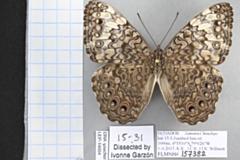Project 2688: I. J. Garzón-Orduña, A. V. Brower, M. Kamilari, A. Iribar, J. Murienne. 2018. Cracking the Code: Examination of Species Delimitations among Hamadryas Butterflies with DNA Barcodes Suggests Caribbean Cracker is Hamadryas februa Hübner (Nymphalidae: Biblidinae). Journal of the Lepidopterists. 72 (1):53-73.
Abstract
Hamadryas februa Hübner and close relatives H. amphichloe Boisduval, H. glauconome Bates and H. julitta Fruhstorfer are a homogeneous group of taxa loosely defined as different species mainly by a combination of wing color characters. Here we explored the utility of the mtDNA COI barcode region in delimiting these taxa and examined its overall performance to identify species of Hamadryas. We compiled all the barcode sequences available for 16 of the 20 species in the genus, and added new sequences from 34 samples for 8 species from Peru and Ecuador. The complete data set includes 260 individuals. After filtering out identical sequences, a parsimony analysis of 142 individuals with unique haplotypes found that almost all the samples grouped according to their traditional species identification. The exceptions were samples of H. amphichloe diasia Fruhstorfer from the Dominican Republic and H. amphichloe ferox Staudinger from Colombia, which grouped with samples of H. februa. The barcodes of widespread species or polytypic species such as H. laodamia Cramer, H. arinome Lucas and H. februa grouped according to the geographic limits of their subspecies, but this was not the case for H. amphichloe, H. feronia Linnaeus, H. amphinome Linnaeus and H. guatemalena Bates. Our results suggest that of the three subspecies of H. amphichloe included here, only H. amphichloe amphichloe Boisduval, originally described from Ecuador, should be considered a distinct species, and that H. amphichloe diasia and H. amphichloe ferox do not belong to that lineage, but instead are part of H. februa. Furthermore we found extensive intraspecific sequence variation that overlapped with interspecific genetic distances of closely related species. We offer some general comments on species delimitation by tree-based and distance-based approaches. In conclusion, our dataset shows that the majority of the species Hamadryas included here can be distinguished by their barcode sequence (11 of 16 or about half of the species in the genus). However, the geographical coverage of our dataset is somewhat limited. Broader sampling of widespread species and the comprehensive inclusion of samples from closely related species will determine the utility of the barcode with more confidence.Read the article »
Article DOI: 10.18473/lepi.72i1.a6
Project DOI: 10.7934/P2688, http://dx.doi.org/10.7934/P2688
| This project contains |
|---|
Download Project SDD File |
Currently Viewing:
MorphoBank Project 2688
MorphoBank Project 2688
- Creation Date:
16 May 2017 - Publication Date:
03 December 2019 - Media downloads: 1

This research
supported by
Authors' Institutions ![]()
- Centre National de la Recherche Scientifique (CNRS)
- Universite Paul Sabatier Toulouse
- Middle Tennessee State University
- University of Patras

